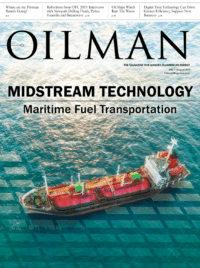Gas flaring is the process of burning excess hydrocarbon gases, which cannot be recovered or recycled, and combining those gases with steam or air to produce water vapor and carbon dioxide. Gas flaring is commonly used in industrial plants such as chemical plants and petroleum refineries. While flaring is a common and efficient process utilized by many oil refineries to safely dispose of excess gas, there have been criticisms on the effects of gas flaring, including its impact on the environment.
With a more environmentally conscious society, there has been a significant push for the oil and gas industry to make operations eco-friendlier. Steve Coates, CEO of Brainnwave, an oil and gas software and solution company, provided his perspective on the effects of gas flaring, stating “The industry is under increasing pressure to reduce gas flaring due to the environmental impact – and to put the wasted gas to better use.” According to Coates, The World Bank has a target to eliminate gas flaring by 2030, an ambition which has had significant buy in from industry and major oil producing economies.
With that said, many oil and gas corporations are turning to oil and gas solutions companies and integrating refining and processing software to improve their operations.
Around 150Bn cubic meters of gas is flared worldwide on a yearly basis. According to Coates, that is the equivalent of $20bn USD worth of gas or a third of the EUs total gas production. As such, flaring gas is a very common process used by oil and chemical plants, and as a result, unavoidable in certain circumstances. Coates explained, however, that “there are some solutions that enable operators to monetize the gas, which has a direct upward benefit on the environment as well as their own bottom line.” Utilizing eco-conscious solutions and software may prove to be beneficial to chemical plants and oil refineries that regularly flare gas.
Oil and gas solution and data companies, like Brainnwave, are developing ways to monitor and track gas flares and make gas flaring less harmful on the environment. Brainnwave, for example, developed a system for pinpointing gas flaring throughout the world using night-time satellite imagery. Coates shared how they have “developed algorithms for quantifying the volume of gas flared at each site.”
Software tools have even been developed to turn gas flares into electricity, thus making them useful economically and environmentally. On the topic of making gas flares useful, Brainnwave has also developed a unique software, called Ossian, which scrapes the web to identify who to approach when a gas flaring is pinpointed. “We embed this all in an end to end digital platform that enables our clients to take data from space and, in just a few clicks, identify who they should speak to in order to present their value proposition,” Coates explained.
It appears much value is to be found in gas flaring, with the use of proper software and solutions. Once resistant to change, the traditional oil and gas industry is beginning to adopt digital transformation at a much faster rate. According to Coates, however, the challenge is to “cut through the hype and buzz words and identify the viable opportunities to bring about real change.” The current digital age presents new opportunities and new discoveries in oil and gas operations, including technological solutions for refining and gas flaring. The challenge for most oil and gas companies will be adopting these new technologies and adapting to change. As Coates explains, “Technology moves so fast today, that the old methods of delivering technology programs are no good.”
With the rise and demand of software in the industry, oil and gas companies will have to stay competitive and adopt and adjust to new technologies at a rapid pace. “By the time the technology is implemented, it is already out of date. Any technology that you thought of as giving you a competitive advantage is being superseded the minute you implement it,” Coates explained. With an increase of products coming to market for gas flaring, oil and gas companies will need to consistently stay up to date with the latest software and trends in order not to fall behind.
According to Coates, many oil and gas companies will need to undergo organizational change and the methods of agile software development need to become the methods of doing business. “Architecture needs to be designed as a series of interconnected micro-services that enable you to switch out one element without collapsing the entire project,” Coates explained. With society migrating to a more eco-conscious future, the industry needs to develop new ways to make resources greener. As Coates expresses, the industry should also, if possible, make resources “benefit local communities.” “Brainnwave can help support that process by providing the valuable data insights, which enable companies to work collaboratively together and deliver change,” said Coates.
With gas flaring marked as one of the contributors to the release of significant amounts of carbon dioxide into the atmosphere, many oil and gas companies are ready to make environmentally-driven changes. One major problem is integrating or developing the software to do so. As Coates describes, “Digital has the potential to replace complex analytical processes but it will never replace human intelligence.” The industry needs to figure out where AI techniques can reduce the risk of bad decisions and increase the efficiency of the operations, so that the difficult tasks that require intuition, empathy, understanding and heart can be the focus of the team.” Tackling the issue with oil and gas solutions companies may be advantageous for those looking to implement operational change at a quicker rate.
Coates expressed how companies need to embrace the concept of ‘agile’ in their business and set themselves up to be able to make quick decisions. “Businesses shouldn’t be afraid to partner. The ‘buy v. build’ question will always be there, but to truly innovate you need to partner with companies whose only job is to deliver innovative technology,” Coates explained.
As more oil and gas companies adapt to and integrate software and technology, the industry can expect to see significant changes. In addition, as more businesses partner with oil and gas solution and data companies, the industry may see major enhancements in gas flaring in the near future. Although gas flaring has been utilized in the same manner by chemical plants and refineries for years, the development of eco-conscious and value-driven software has opened the path for change. “We need radical new ideas to drive the change required and I’m very excited to be a part of that journey,” said Coates.
Tonae’ Hamilton has been a contributor and associate editor to the magazine for two years. She has been writing professionally for almost four years. In her free time, Tonae’ likes to spend time with her three pets, cook, and binge-watch Netflix shows. Tonae' has a Bachelor of Arts in Communication from McDaniel College.










